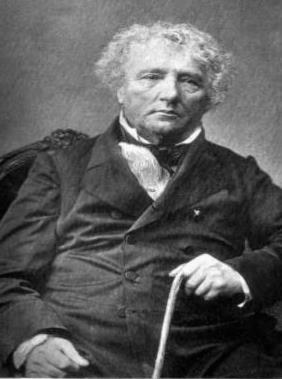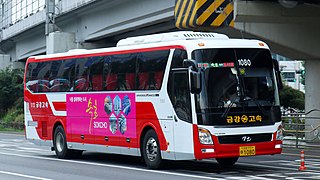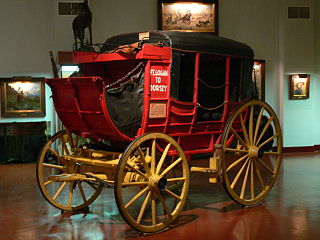
A coach is a type of bus built for longer-distance service, in contrast to transit buses that are typically used within a single metropolitan region. Often used for touring, intercity, and international bus service, coaches are also used for private charter for various purposes. Coaches are also related and fall under a specific category/type of RVs.

A carriage is a two- or four-wheeled horse-drawn vehicle for passengers. Second-hand private carriages were common public transport, the equivalent of modern cars used as taxis. Carriage suspensions are by leather strapping or, on those made in recent centuries, steel springs. Two-wheeled carriages are usually owner-driven.

Charles Bianconi was an Italo-Irish entrepreneur. Sometimes described as the "man who put Ireland on wheels", he developed a network of horse-drawn coaches that became Ireland's "first regular public transport" system. He eventually became known for his innovations in transport and was twice mayor of Clonmel, in County Tipperary.

Cobb & Co was the name used by several independent Australian coach businesses. The first company to use 'Cobb & Co' was established in 1853 by American Freeman Cobb and his partners. The name grew to great prominence in the late 19th century, when it was carried by many stagecoaches carrying passengers and mail to various Australian goldfields, and later to regional and remote areas of the Australian outback. The same name was used in New Zealand and Freeman Cobb used it in South Africa.

Butterfield Overland Mail was a stagecoach service in the United States operating from 1858 to 1861. It carried passengers and U.S. Mail from two eastern termini, Memphis, Tennessee, and St. Louis, Missouri, to San Francisco, California. The routes from each eastern terminus met at Fort Smith, Arkansas, and then continued through Indian Territory (Oklahoma), Texas, New Mexico, Arizona, Mexico, and California ending in San Francisco. On March 3, 1857, Congress authorized the U.S. postmaster general, at that time Aaron V. Brown, to contract for delivery of the U.S. mail from St. Louis to San Francisco. Prior to this, U.S. Mail bound for the Far West had been delivered by the San Antonio–San Diego Mail Line since June 1857.

An intercity bus service or intercity coach service, also called a long-distance, express, over-the-road, commercial, long-haul, or highway bus or coach service, is a public transport service using coaches to carry passengers significant distances between different cities, towns, or other populated areas. Unlike a transit bus service, which has frequent stops throughout a city or town, an intercity bus service generally has a single stop at one location in or near a city, and travels long distances without stopping at all. Intercity bus services may be operated by government agencies or private industry, for profit and not for profit. Intercity coach travel can serve areas or countries with no train services, or may be set up to compete with trains by providing a more flexible or cheaper alternative.

A post-chaise is a fast carriage for traveling post built in the 18th and early 19th centuries. It usually had a closed body on four wheels, sat two to four persons, and was drawn by two or four horses.

A horse-drawn vehicle is a piece of equipment pulled by one or more horses. These vehicles typically have two or four wheels and were used to carry passengers or a load. They were once common worldwide, but they have mostly been replaced by automobiles and other forms of self-propelled transport but are still in use today.

A postilion or postillion is a person who guides a horse-drawn coach or post chaise while mounted on the horse or one of a pair of horses. By contrast, a coachman controls the horses from the vehicle itself.

A mail coach is a stagecoach that is used to deliver mail. In Great Britain, Ireland, and Australia, they were built to a General Post Office-approved design operated by an independent contractor to carry long-distance mail for the Post Office. Mail was held in a box at the rear where the only Royal Mail employee, an armed guard, stood. Passengers were taken at a premium fare. There was seating for four passengers inside and more outside with the driver. The guard's seat could not be shared. This distribution system began in Britain in 1784. In Ireland the same service began in 1789, and in Australia it began in 1828.

The Stage Coaches Act 1790 was an Act of Parliament of the Parliament of Great Britain to regulate the use of stagecoaches.

A coach is a large, closed, four-wheeled, passenger-carrying vehicle or carriage usually drawn by two or more horses controlled by a coachman, a postilion, or both. A coach has doors in its sides and a front and a back seat inside. The driver has a raised seat in front of the carriage to allow better vision. It is often called a box, box seat, or coach box. There are many types of coaches depending on the vehicle's purpose.

The Horseshoe Barn and Horseshoe Barn Annex are two exhibit buildings located at Shelburne Museum in Shelburne, Vermont. Both buildings exhibit a variety of horse-drawn vehicles, including carriages, trade wagons, stagecoaches, and sleighs.

A horse-bus or horse-drawn omnibus was a large, enclosed, and sprung horse-drawn vehicle used for passenger transport before the introduction of motor vehicles. It was mainly used in the late 19th century in both the United States and Europe, and was one of the most common means of transportation in cities. In a typical arrangement, two wooden benches along the sides of the passenger cabin held several sitting passengers facing each other. The driver sat on a separate, front-facing bench, typically in an elevated position outside the passengers' enclosed cabin. In the main age of horse buses, many of them were double-decker buses. On the upper deck, which was uncovered, the longitudinal benches were arranged back to back.

Stage wagons are light horse-drawn or mule-drawn public passenger vehicles often referred to as stagecoaches. Like stagecoaches they made long scheduled trips using stage stations or posts where the horses would be replaced by fresh horses. Stage wagons were intended for use in particularly difficult conditions where standard stagecoaches would be too big and too heavy.

A stage station or relay station, also known as a staging post, a posting station, or a stage stop, is a facility along a main road or trade route where a traveller can rest and/or replace exhausted working animals for fresh ones, since long journeys are much faster with fewer delays when using well fed and rested mounts. Stage is the space between the places known as stations or stops — also known in British English as posts or relays.

Abbot-Downing Company was a coach and carriage builder in Concord, New Hampshire, which became known throughout the United States for its products — in particular the Concord coach.

A post house, posthouse, or posting house was a house or inn where horses were kept and could be rented or changed out. Postriders could also be hired to take travellers by carriage or coach and delivered mail and packages on a route, meeting up at various places according to a schedule. Routes included post roads. A postmaster was an individual from whom horses and/or riders known as postilions or "post-boys" who might help a coachman drive coaches could be hired. A postilion might also travel on a coach to take back his employer's horses. The postmaster would reside in the post house.

The Concord coach was an American horse-drawn coach, often used as stagecoaches, mailcoaches, and hotel coaches. The term was first used for the coaches built by coach-builder J. Stephen Abbot and wheelwright Lewis Downing of the Abbot-Downing Company in Concord, New Hampshire, but later to be sometimes used generically. Like their predecessors, the Concords employed a style of suspension and construction particularly suited to North America's early 19th century roads. Leather thoroughbraces suspend passengers who are in constant motion while the coach is moving. The swaying is accepted by passengers for the shock absorbing action of the leather straps and for the way the special motion eases the coach over very rough patches of roadway. This suspension, which was developed by Philip de Chiese in the 17th century, was long replaced by steel springs in England.

A coupé was a four-wheeled carriage with outside front seat for the driver and enclosed passenger seats for two persons. The name coupé comes from the French past participle of couper, "cut".



































